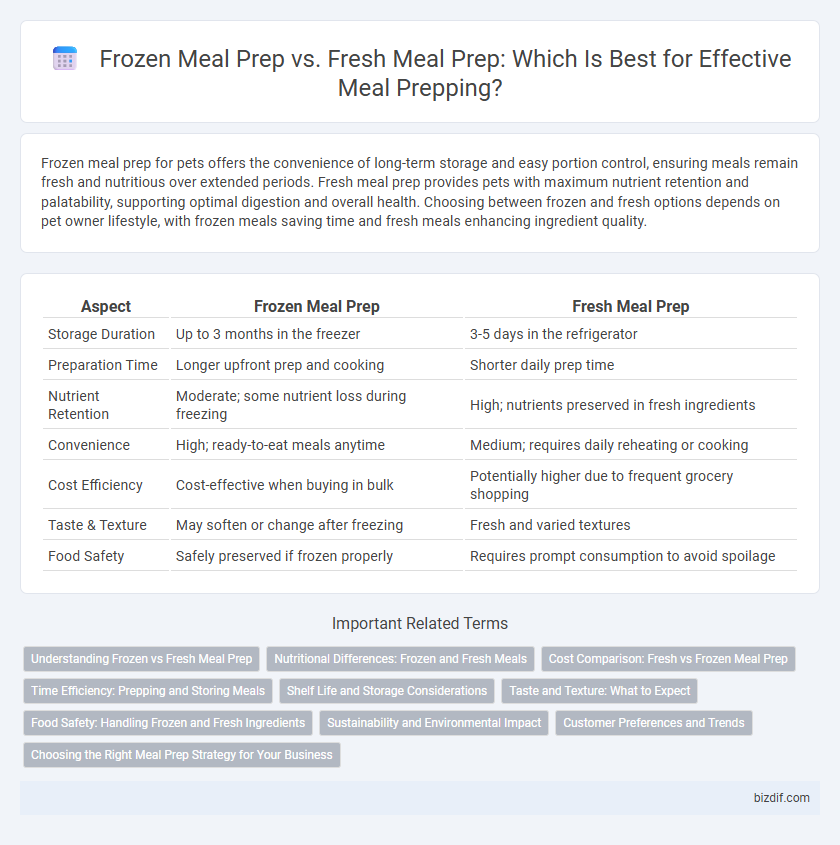Frozen meal prep for pets offers the convenience of long-term storage and easy portion control, ensuring meals remain fresh and nutritious over extended periods. Fresh meal prep provides pets with maximum nutrient retention and palatability, supporting optimal digestion and overall health. Choosing between frozen and fresh options depends on pet owner lifestyle, with frozen meals saving time and fresh meals enhancing ingredient quality.
Table of Comparison
| Aspect | Frozen Meal Prep | Fresh Meal Prep |
|---|---|---|
| Storage Duration | Up to 3 months in the freezer | 3-5 days in the refrigerator |
| Preparation Time | Longer upfront prep and cooking | Shorter daily prep time |
| Nutrient Retention | Moderate; some nutrient loss during freezing | High; nutrients preserved in fresh ingredients |
| Convenience | High; ready-to-eat meals anytime | Medium; requires daily reheating or cooking |
| Cost Efficiency | Cost-effective when buying in bulk | Potentially higher due to frequent grocery shopping |
| Taste & Texture | May soften or change after freezing | Fresh and varied textures |
| Food Safety | Safely preserved if frozen properly | Requires prompt consumption to avoid spoilage |
Understanding Frozen vs Fresh Meal Prep
Frozen meal prep preserves nutrients and flavors by locking in freshness soon after cooking, making it ideal for long-term storage and minimizing food waste. Fresh meal prep offers immediate access to meals with optimal texture and taste but requires quick consumption to maintain quality. Balancing frozen and fresh meal options enhances dietary flexibility and streamlines weekly meal planning.
Nutritional Differences: Frozen and Fresh Meals
Frozen meal prep retains most nutrients due to flash-freezing techniques that preserve vitamins and minerals, particularly in vegetables and fruits, while minimizing nutrient degradation over time. Fresh meal prep often contains higher levels of certain heat-sensitive nutrients like vitamin C, but its nutritional value can decrease rapidly if meals are stored for extended periods before consumption. Studies show that both frozen and fresh meals provide comparable macronutrient profiles, but fresh meals may have a slight advantage in antioxidant retention when consumed immediately.
Cost Comparison: Fresh vs Frozen Meal Prep
Frozen meal prep typically reduces overall costs by extending ingredient shelf life and minimizing food waste, making bulk purchases more economical. Fresh meal prep often incurs higher expenses due to frequent shopping trips and spoilage risks, requiring more time investment for daily preparation. Evaluating budget constraints and lifestyle preferences helps determine whether the cost efficiency of frozen meals or the nutritional benefits of fresh meals align better with individual needs.
Time Efficiency: Prepping and Storing Meals
Frozen meal prep offers significant time efficiency by allowing bulk cooking and long-term storage, minimizing daily cooking efforts and reducing meal planning frequency. Fresh meal prep requires more frequent preparation sessions, which can increase time spent on chopping, cooking, and daily storage management. Utilizing airtight containers and labeling for frozen meals further streamlines organization and quick access during busy schedules.
Shelf Life and Storage Considerations
Frozen meal prep significantly extends shelf life, often preserving meals for 3 to 6 months, whereas fresh meal prep typically lasts only 3 to 5 days in the refrigerator. Proper freezing techniques, such as airtight containers and rapid cooling, are essential to maintain nutritional quality and prevent freezer burn, while fresh meals require consistent refrigeration at 40degF or below to inhibit bacterial growth. Storage considerations also include the convenience of batch freezing for portion control in frozen prep, compared to the need for frequent consumption or repurposing of fresh meals to minimize waste.
Taste and Texture: What to Expect
Frozen meal prep often results in slight changes in texture, such as softer vegetables and altered moisture levels in proteins, due to ice crystal formation during freezing. Fresh meal prep typically preserves the original taste and crispness, offering a more vibrant flavor profile and firmer texture. Choosing between frozen and fresh depends on balancing convenience with the desired sensory experience of meals.
Food Safety: Handling Frozen and Fresh Ingredients
Proper food safety during meal prepping involves careful handling of both frozen and fresh ingredients to prevent contamination and spoilage. Frozen ingredients must be thawed safely, ideally in the refrigerator or using the defrost setting on a microwave, to minimize bacterial growth. Fresh ingredients require thorough washing, prompt refrigeration, and cooking to appropriate temperatures to ensure food safety and maintain nutritional quality.
Sustainability and Environmental Impact
Frozen meal prep significantly reduces food waste and energy consumption by preserving ingredients longer, minimizing spoilage compared to fresh meal prep, which often results in higher perishability and frequent refrigeration cycles. The energy footprint of freezing processes is offset by decreased need for daily cooking and reduced frequency of grocery trips, lowering carbon emissions associated with transportation and packaging. Sustainable meal prepping favors freezing methods as they optimize resource use while maintaining nutritional value and minimizing environmental strain.
Customer Preferences and Trends
Customer preferences in meal prepping increasingly favor frozen meal prep for its convenience, extended shelf life, and reduced food waste. Recent trends indicate a growing demand for healthy frozen options made from fresh, natural ingredients to balance nutrition and time-saving benefits. Market analysis reveals that younger consumers prioritize flexibility, while older demographics lean toward fresh meal prep for perceived quality and taste.
Choosing the Right Meal Prep Strategy for Your Business
Selecting the right meal prep strategy for your business depends on factors like target market preferences, shelf-life requirements, and operational capacity. Frozen meal prep offers extended storage, reduced food waste, and scalability for bulk orders, making it ideal for businesses targeting convenience and long-distance delivery. Fresh meal prep appeals to health-conscious consumers seeking high-quality ingredients and immediate consumption, benefiting local businesses focused on daily sales and freshness.
Frozen meal prep vs Fresh meal prep Infographic

 bizdif.com
bizdif.com